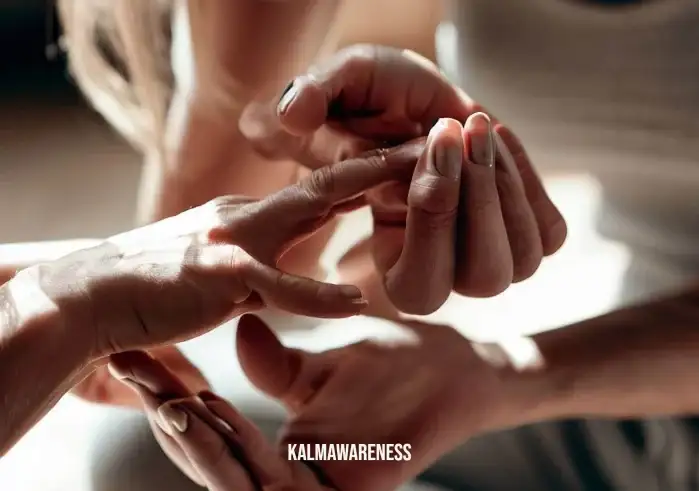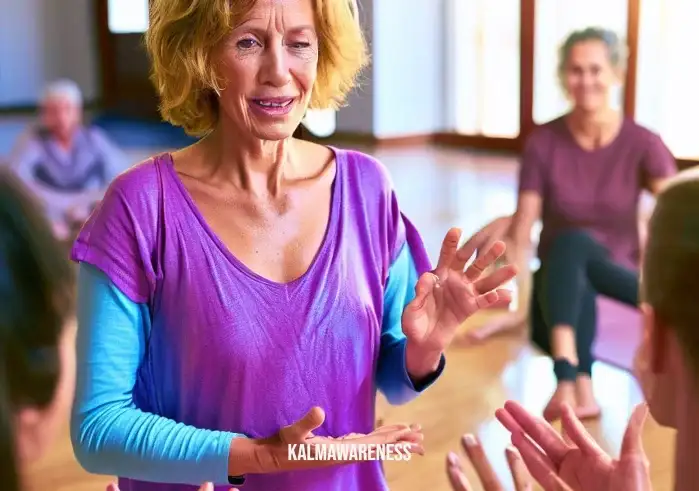Yoga Tips for the Hands: A Comprehensive Guide to Enhance Your Practice
Your hands, those miracles of engineering, play an integral part in your yoga practice. But how often do you think about them? In the world of yoga, it’s common to focus on postures that involve the entire body or specific areas like the back or legs. However, hands, too, deserve equal attention. This article aims to provide valuable yoga tips for the hands, enhancing your overall yoga experience and promoting optimal wellness.
Understanding the Importance of Hands in Yoga
The importance of hands in yoga cannot be overstated. Your hands are the primary contact points with the earth in many yoga poses. They ground you, balance you, and aid in the alignment of other body parts. In other words, your hands help guide the flow of energy through your body and contribute to the stability and effectiveness of your poses.
While you might have practiced various right hand poses or sit poses in yoga, understanding the role of hands beyond just poses can be illuminating. As noted in yoga and mindfulness therapy, mindfulness about each body part, including hands, enriches your practice.
Practical Yoga Tips for the Hands
Now that we’ve highlighted the role of hands in yoga, let’s dive into some practical yoga tips for the hands. But remember, the journey to flexibility and strength isn’t an overnight venture. Be patient with yourself.
1. Prioritize Warm-Up
Just as warming up is crucial before engaging in any form of exercise, it’s equally important in yoga. The practice of yoga involves a lot of stretching, twisting, and balancing. By warming up, you’re preparing your hands and the rest of your body for the movements and postures that follow.
A gentle way to warm up your hands is through ‘Anjali Mudra’ or the prayer pose. This pose brings your palms together, aligning your fingers and activating the muscles in your hands and wrists. You might recognize this pose from the twisted root yoga pose or during the closing final savasana in most yoga classes.
2. Hand Alignment is Key
When you place your hands on the mat, pay attention to their alignment. Your hands should be shoulder-width apart, with fingers spread wide. This hand placement is important for poses like Downward-Facing Dog, Plank, and Handstand, offering stability and balance.
To enhance your understanding of hand alignment, explore resources like our guide to yoga postures stick figures. Not only do these visuals aid in achieving the correct hand placement, but they also help you understand the body’s overall alignment in various yoga poses.
3. Strengthen Your Hand Muscles
In yoga, your hands carry a lot of your body weight in various poses. Thus, building strength in your hands is essential. One way to do this is through ‘Hasta Bandha’ or the hand lock. This involves actively pressing your hands into the mat while equally distributing your weight across all parts of the hand.
Additionally, incorporate exercises that target your hand and wrist muscles. For instance, the ‘fetal pose’ (garbhasana), explained in our guide, involves a strong grip and can help build hand strength.
Just remember, developing strength takes time and consistent practice, so be patient with yourself.
“Hands are the most honest part of the human body, they cannot lie as laughing eyes and the mouth can.” – M.C Escher
Now that we’ve touched the surface of yoga tips for the hands, are you ready to delve deeper? In the next section of our article, we’ll explore how to prevent common hand-related yoga injuries and some special poses to improve your hand flexibility and strength. The world of yoga extends beyond your mat. Discover the power and potential in your hands as you continue with us to the next part of our exploration.

Addressing Common Hand-Related Concerns in Yoga
Incorporating the above yoga tips for the hands into your practice is the first step. However, it’s also crucial to address common concerns that yoga practitioners face when it comes to their hands. In this section, we will tackle two primary issues – avoiding injuries and improving flexibility.
Preventing Yoga Injuries in Hands
In the realm of yoga, hand injuries, while less common, can still occur. Thankfully, they’re preventable with a bit of mindfulness and the right techniques.
- Avoid Hyperextension: Hyperextending your wrists or fingers while performing yoga poses can cause strain or injury. To prevent this, make sure you’re evenly distributing your body weight in hand-intensive poses.
- Mind Your Alignment: As emphasized in our guide on teaching yoga beyond the poses, proper alignment is crucial. This is not just about maintaining the pose but also about ensuring your body is working effectively and safely.
- Listen to Your Body: Recognize the difference between a good stretch and pain. As highlighted in our blog It’s Your Own Body and Mind, learning to listen and respect your body’s signals is key to avoiding injuries.
Enhancing Hand Flexibility
Just like any other body part, hands require regular exercise to maintain their flexibility. Here are some exercises that can aid in improving the suppleness of your hands:
- Finger Stretches: Extend your hand with fingers straight, then bend the fingers at the middle and base joints while keeping the rest of the hand straight. This can be a good warm-up before your yoga practice.
- Wrist Rolls: Extend your arm out with your palm facing down, slowly rotate your wrist in circular motions. This exercise helps loosen your wrists, increasing their range of motion.
- Hand Shake: Just as it sounds, shake your hands as if you’re trying to air dry them. This simple movement helps to relax the hand muscles.
For more hand flexibility exercises, check out our Sara Ivanhoe Yoga YouTube series. Her videos offer easy-to-follow routines that cater to different areas of the body, including hands.
Yoga Poses That Benefit Your Hands
Let’s now explore some specific yoga poses that can offer added benefits to your hands. Here, we present a table detailing a few beneficial yoga poses for your hands:
| Yoga Pose | Benefits |
|---|---|
| Downward-Facing Dog (Adho Mukha Svanasana) | Strengthens the hands and wrists, improves circulation to the hands. |
| Upward-Facing Dog (Urdhva Mukha Svanasana) | Enhances wrist flexibility and strengthens hand muscles. |
| Crow Pose (Bakasana) | Develops hand and finger strength, improves balance. |
| Handstand (Adho Mukha Vrksasana) | Builds hand and wrist strength, improves balance and stability. |
It’s also worth exploring poses from our subtle body yoga sequence, which focuses on activating and balancing energy channels in the body, including the hands.
Remember that every journey of yoga practice is unique, and what works well for others might not be the same for you. The goal is not perfection, but progression. As you continue on this journey, let the essence of mindful flow guide you – it’s about the journey, not the destination.
As we close this section of our article, we invite you to continue to the final part where we’ll discuss the spiritual significance of hands in yoga and how they contribute to a more wholesome and mindful practice. Join us in the next section as we delve deeper into these fascinating concepts.

Hands in Yoga: More Than Just Physical Support
The journey of yoga is as much spiritual as it is physical. The hands, in particular, play an essential role in both these aspects. In this section, we will delve into the deeper symbolic and energetic meanings of hands in yoga and how these interpretations can enhance your practice.
Hands as Energy Channels
In the practice of yoga, the hands are considered gateways to our inner energy. According to yogic philosophy, each finger on our hand is associated with a specific energy element. For an in-depth understanding of how energy flows within our body and how it influences our physical and mental wellbeing, delve into our comprehensive guide on the subtle body yoga sequence.
As we grow in our yoga practice, learning to channelize this energy can bring about an increased sense of calm and balance in our lives. This understanding reaffirms the importance of incorporating yoga tips for the hands into our practice.
Mudras: Hand Gestures in Yoga
Mudras, or yogic hand gestures, are a crucial part of the yoga tradition. Each mudra serves a specific purpose and can have a transformative effect on our mental and physical health when practiced regularly.
For instance, Gyan Mudra, often used in meditation, is believed to enhance concentration and memory. It’s performed by touching the tip of the thumb to the tip of the index finger while keeping the other fingers straight.
Mudras can offer a fascinating dimension to your yoga practice. Discover more about this topic in our article on mindful alternatives.
The Spiritual Significance of Hands in Yoga
Our hands are not merely functional appendages; they’re conduits of our intentions, our actions, and our connections with the world. As the legendary yogi, T. Krishnamacharya said, “Yoga is an awareness, a type of knowing. Yoga will end in awareness.”
The hands are a critical part of this awareness, helping us connect more deeply with ourselves and the world around us. For more inspiration and insightful commentary on the spiritual side of yoga, explore our collection of Dharma talk yoga teachings.
Understanding and incorporating these elements into your yoga practice can provide a more profound sense of fulfillment. After all, the beauty of yoga lies in its holistic approach, uniting body, mind, and spirit.
So, as you incorporate these yoga tips for the hands, remember the wise words of B.K.S Iyengar, one of the foremost yoga teachers in the world, “Yoga is a light, which once lit, will never dim. The better your practice, the brighter the flame.”
Join us in the next part of this article, where we’ll explore hand yoga for specific groups like seniors and office workers. We’ll also dive into the science behind hand yoga and why it’s an excellent practice for overall wellness.

Hand Yoga for Different Populations and the Science Behind It
In this chapter, we’ll shift our focus from the spiritual and symbolic aspects of hand yoga to its practical applications and science-based benefits. As we further explore yoga tips for the hands, we’ll delve into specific routines for different groups, such as seniors and office workers.
Hand Yoga for Seniors
Seniors often deal with conditions like arthritis and decreased mobility, which can limit their physical activity. Here’s where hand yoga can be incredibly beneficial. Hand yoga can be performed seated and doesn’t require much physical exertion, making it an excellent option for seniors to stay active and maintain joint health.
For seniors looking to get started with hand yoga, we recommend visiting our basic yoga for dummies guide, which provides step-by-step instructions and essential tips for beginners.
Hand Yoga Routine for Seniors
| Mudra | Description |
|---|---|
| Gyan Mudra | Touch the tip of the thumb to the tip of the index finger. |
| Prithvi Mudra | Touch the tip of the ring finger to the tip of the thumb. |
| Vayu Mudra | Press the index finger to the base of the thumb and hold with the thumb. |
Hand Yoga for Office Workers
For office workers, carpal tunnel syndrome and repetitive strain injuries are common complaints. Regularly performing hand yoga can help prevent these conditions by reducing stress, improving flexibility, and increasing blood circulation in the hands.
Office workers can integrate hand yoga seamlessly into their daily routine, be it during a break or even while sitting at the desk. To get started, take a look at our mindful living centers in El Paso, where we offer sessions dedicated to workplace wellness, including hand yoga.
Hand Yoga Routine for Office Workers
| Mudra | Description |
|---|---|
| Hakini Mudra | Join the fingertips of both hands together. |
| Prana Mudra | Join the tips of the thumb, ring finger, and little finger together. |
| Surya Mudra | Press the ring finger to the base of the thumb and hold with the thumb. |
The Science Behind Hand Yoga
Several studies support the numerous benefits of hand yoga. For instance, a study in the Journal of Rheumatology found that yoga is safe and beneficial for people with arthritis, helping to improve joint health, flexibility, and physical function.
Our own hands hold the key to wellness and health, reinforcing the importance of including yoga tips for the hands in our practice. As the popular saying by B.K.S. Iyengar goes, “Yoga does not just change the way we see things; it transforms the person who sees.”
To wrap up this chapter, let’s remember the words of American yoga teacher Baron Baptiste: “Yoga is not about self-improvement, it’s about self-acceptance.” As we embrace hand yoga, it’s essential to approach it with an open mind and heart.
In the next part of our journey, we’ll delve into the therapeutic aspects of hand yoga. Expect to learn about hand yoga for pain relief, stress management, and improving mental health. Stay with us to keep lighting the flame of knowledge!

Therapeutic Aspects of Hand Yoga
As we delve further into yoga tips for the hands, we reach the domain where hand yoga intersects with therapy. Hand yoga, when practiced regularly, can be a powerful tool for managing stress, pain, and promoting mental wellness. Let’s explore this therapeutic aspect and how we can leverage it in our day-to-day lives.
Hand Yoga for Pain Relief
Yoga has long been known to assist in pain management. Hand yoga, in particular, is useful for those who suffer from chronic conditions that affect the hands and wrists, like arthritis, carpal tunnel syndrome, or tendinitis. The gentle movements and holds associated with hand yoga stimulate blood flow, improve flexibility, and reduce inflammation.
There are specific mudras, like the Vayu Mudra, that have been traditionally used to alleviate joint pain and stiffness. To learn more about this mudra and others, consider visiting our page on yoga postures stick figures that illustrates these mudras in an easy-to-understand way.
Hand Yoga for Stress Management
In this fast-paced world, managing stress effectively is crucial. Hand yoga can be a natural and holistic method for stress relief. By focusing on the movement and positioning of your hands, you can draw your attention away from your stressors, cultivating a calming sense of mindfulness.
For instance, the Gyan Mudra, often referred to as the “seal of knowledge,” promotes mental clarity and relaxation. Explore more about this mudra in our mindful flow series, where we integrate mindfulness practices with yoga.
Hand Yoga for Mental Wellness
Just as physical exercise is essential for bodily health, activities that stimulate our minds, like hand yoga, are critical for our mental wellbeing. It provides a focused, meditative practice that can combat anxiety, improve concentration, and promote a general sense of wellness.
Our blog post titled on all things meditated dives deep into meditation’s mental wellness benefits and how to integrate it with yoga practice.
Remember, the journey of yoga is one of patience and consistent practice. As T.K.V. Desikachar, a renowned yoga teacher and therapist, once said, “The success of Yoga does not lie in the ability to perform postures but in how it positively changes the way we live our life and our relationships.”
Let’s now transition to our final chapter. We’ll be exploring how hand yoga can be integrated into a holistic lifestyle, delving into aspects like diet, sleep, and a balanced routine. Let’s continue our journey into yoga tips for the hands and achieve a more harmonious lifestyle.

Integrating Hand Yoga into a Holistic Lifestyle
In our final exploration of yoga tips for the hands, we’ll discuss how hand yoga can seamlessly blend into a holistic lifestyle. A holistic lifestyle is one that focuses on complete wellbeing—mind, body, and spirit. Hand yoga can be a potent tool in maintaining balance across all these aspects.
Hand Yoga and Diet
A balanced diet plays a crucial role in the effectiveness of any yoga practice. Including anti-inflammatory foods, such as berries, fatty fish, and green leafy vegetables, can enhance your body’s response to hand yoga. Additionally, staying hydrated is key to maintaining healthy joints.
For more details on diet, visit our mindful alternatives blog where we explore healthier food choices that work harmoniously with a yoga practice.
Hand Yoga and Sleep
Proper sleep is critical for recovery and growth. The relaxation and stress-relief that hand yoga provides can help prepare your mind and body for a good night’s sleep. Certain hand mudras, like the Shunya Mudra, can help mitigate insomnia. Explore our section on deep sleep yoga nidra for a deeper understanding of the connection between yoga and sleep.
Hand Yoga and Routine
Incorporating hand yoga into your daily routine can work wonders. Setting aside specific times for hand yoga—perhaps in the morning for an energizing start or in the evening for a calming end—can enhance its benefits. Routine practice also develops discipline, a valuable life skill.
To get you started, we have a yoga for night routine that includes hand yoga exercises to help you unwind.
Hand Yoga and Community
Finally, remember that yoga is more than just a personal practice—it’s also a community. Sharing your hand yoga journey with others not only encourages consistency but also brings a sense of shared joy and discovery. Explore our mindful movers nashville tn community to find like-minded individuals on a similar path.
As we conclude this comprehensive exploration of yoga tips for the hands, remember the words of Yoga guru B.K.S. Iyengar: “Yoga does not just change the way we see things; it transforms the person who sees.” Here’s hoping that hand yoga brings a positive transformation in your life, enriching your journey to holistic wellness.
Thank you for joining us on this exploration. We invite you to delve further into other topics on our website and deepen your understanding of yoga, wellness, and more. Happy yoga journey!





